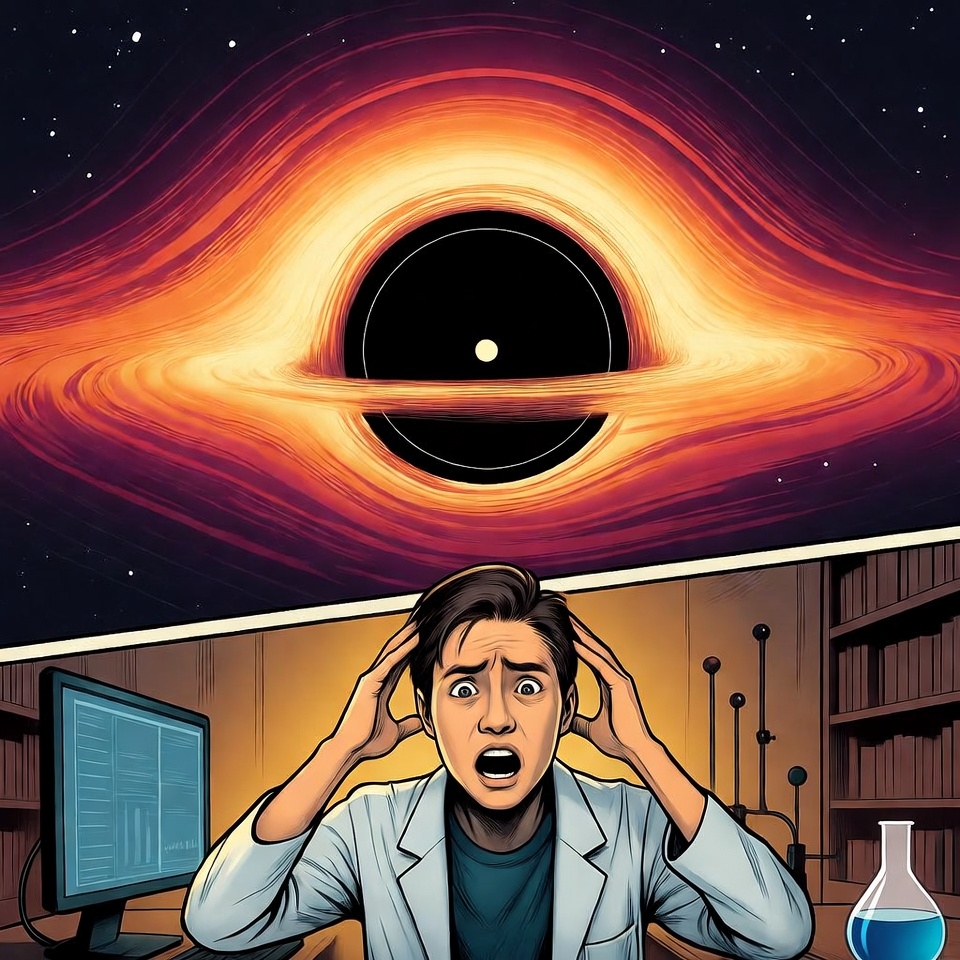Have you ever wondered what secrets lie beyond the event horizon of a black hole? What if everything we thought we knew about these cosmic monsters was wrong? In a groundbreaking discovery that’s sending shockwaves through the scientific community, researchers have finally pieced together what might actually happen inside a black hole—and the reality is far stranger than anyone imagined.
For decades, black holes have been the universe’s ultimate mystery box. These gravitational giants have captured our imagination in movies, books, and countless late-night conversations about the cosmos. But now, thanks to advanced quantum physics simulations and revolutionary mathematical models, scientists are pulling back the curtain on one of nature’s most closely guarded secrets.
The Mystery That’s Haunted Scientists for Generations
Black holes have puzzled physicists ever since Karl Schwarzschild first calculated their existence in 1916. What happens when you cross the point of no return? Does time stop? Do you get stretched like spaghetti? Does information truly vanish forever, or does something else happen that we’ve never considered?
These aren’t just academic questions for theoretical physicists working in ivory towers. Understanding what happens inside black holes could revolutionize our understanding of quantum mechanics, gravity, and the very fabric of spacetime itself. The implications stretch far beyond astronomy—they touch on the fundamental laws that govern our entire universe.
What Scientists Actually Discovered Inside Black Holes
The latest research, combining quantum gravity theories with advanced computer simulations, reveals something extraordinary. Instead of the infinite crushing singularity that scientists predicted for years, black holes might actually contain something far more complex and mind-bending.
According to the new models, what happens inside a black hole involves a radical transformation of space and time. As matter crosses the event horizon—the boundary beyond which nothing can escape—it doesn’t simply get crushed into oblivion. Instead, the extreme gravitational forces create what physicists call a “quantum bounce.”
This quantum bounce effect suggests that matter doesn’t reach an infinitely dense point. Instead, the incredible pressure triggers quantum mechanical effects that create a kind of repulsive force. Think of it like squeezing a spring—at first it compresses, but at a certain point, the spring’s internal structure resists further compression.
The Event Horizon Isn’t What We Thought
For years, scientists believed crossing the event horizon meant immediate doom. The popular theory suggested you’d experience “spaghettification”—where tidal forces would stretch you into a long, thin strand before crushing you completely. While this dramatic stretching does occur, the new research reveals the story doesn’t end there.
The event horizon itself might be more of a transition zone than a hard boundary. Recent mathematical models suggest it could be a region where the normal rules of physics gradually give way to quantum effects. This means what happens at the event horizon of a black hole is far more nuanced than the simple “point of no return” we’ve imagined.
How Black Holes Really Work: Breaking Down the Science
Understanding what really happens inside a black hole requires us to think about gravity in a completely new way. Einstein’s general relativity tells us that massive objects warp the fabric of spacetime, creating what we perceive as gravity. Black holes take this to the extreme—they warp spacetime so severely that they create a region from which not even light can escape.
But here’s where it gets fascinating. The interior of a black hole isn’t just empty space getting crushed. According to the latest black hole physics discoveries, the interior might contain exotic forms of matter and energy we’ve never encountered. Some theoretical models suggest the formation of what physicists call “Planck stars”—ultra-dense objects held up by quantum pressure rather than collapsing completely.
The Information Paradox Solution
One of the biggest puzzles in black hole physics has been the information paradox. Quantum mechanics tells us that information can never be truly destroyed, but black holes seemed to violate this rule. When something falls into a black hole, where does all the information about its quantum state go?
The new discoveries about black hole interiors might finally solve this decades-old puzzle. If matter doesn’t reach a true singularity but instead undergoes a quantum bounce, then information could be preserved in the quantum states of the particles inside the black hole. Some theories even suggest this information could eventually escape through Hawking radiation—the quantum mechanical process where black holes slowly evaporate over time.
What Happens When You Fall Into a Black Hole
Let’s imagine you’re falling into a black hole. What would you actually experience? The answer depends on whether you’re watching from outside or experiencing it yourself—and the difference is crucial for understanding black hole mysteries.
From your perspective falling in, time would seem to flow normally. You’d cross the event horizon without noticing anything special happening at that exact moment. However, as you ventured deeper, you’d start experiencing those extreme tidal forces. Your feet (if falling feet-first) would feel stronger gravity than your head, beginning that infamous spaghettification process.
But here’s the twist the new research reveals: instead of reaching an infinitely dense singularity, you might encounter a region of extremely high but finite density. The quantum effects that create the bounce would kick in at the Planck scale—the smallest meaningful length in physics, about 10^-35 meters.
The View From Outside the Black Hole
For someone watching you fall in from a safe distance, the experience looks completely different. Thanks to the extreme time dilation near black holes, they’d see you slow down as you approached the event horizon. You’d appear to freeze at the edge, your image becoming redder and dimmer until you eventually fade from view.
This difference in perspectives is one of the strangest aspects of black hole physics. It demonstrates how profoundly these objects warp the relationship between space and time.
The Future of Black Hole Research
These discoveries about what’s inside a black hole open up entirely new avenues of research. Scientists are now developing more sophisticated models to understand black hole interiors, combining insights from string theory, loop quantum gravity, and other cutting-edge approaches to quantum gravity.
The Event Horizon Telescope, which captured the first image of a black hole in 2019, continues to gather data that helps test these theories. Future observations of black holes merging, gravitational waves, and the behavior of matter around black holes will provide crucial evidence to support or challenge these new ideas.
What This Means for Understanding the Universe
Understanding what happens inside black holes isn’t just about satisfying curiosity—it has profound implications for cosmology. Some scientists have proposed that our entire universe might have originated from inside a black hole in another universe. If the quantum bounce theory is correct, it could support models of a cyclical universe that undergoes endless cycles of collapse and rebirth.
The connection between black holes and the Big Bang is particularly intriguing. Both involve extreme densities and quantum gravitational effects. By understanding one, we might unlock secrets about the other.
The Biggest Questions Still Remaining
Despite these exciting discoveries, many mysteries about black holes remain unsolved. We still don’t know exactly what happens to matter during the quantum bounce. Does it transform into new forms of exotic matter? Could there be a “white hole” on the other side that expels matter into another region of spacetime or even another universe?
Scientists are also investigating supermassive black holes at the centers of galaxies. These monsters contain millions or billions of times the mass of our sun. Do they follow the same rules as smaller black holes, or do different physics apply at such enormous scales?
How Scientists Study What’s Inside Black Holes
You might wonder how scientists can study something they can never directly observe. The answer lies in clever indirect methods. By studying gravitational waves from merging black holes, analyzing the behavior of matter in accretion disks around black holes, and using advanced mathematical models, physicists can infer what must be happening inside.
Computer simulations play a crucial role in black hole research. Supercomputers can model the extreme conditions near and inside black holes, testing whether different theoretical predictions match what we observe. These simulations combine general relativity, quantum mechanics, and plasma physics to create the most accurate pictures possible of these extreme environments.
Conclusion: A New Era of Black Hole Understanding
The recent discoveries about what happens inside black holes mark a turning point in our understanding of the universe’s most mysterious objects. Rather than being cosmic vacuum cleaners that destroy everything they touch, black holes might be far more complex and interesting than we ever imagined.
As our telescopes become more powerful and our theories more refined, we’ll continue peeling back the layers of mystery surrounding these fascinating objects. The quantum bounce, the preservation of information, the possible connection to other universes—all of these ideas push the boundaries of human knowledge and imagination.
What we’ve learned is that the universe is stranger and more wonderful than we dared to dream. Black holes aren’t the end of the story—they might be gateways to understanding the deepest secrets of reality itself. The journey to understand what really happens inside a black hole is far from over, but we’re closer than ever to solving one of science’s greatest puzzles.








